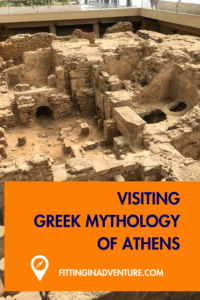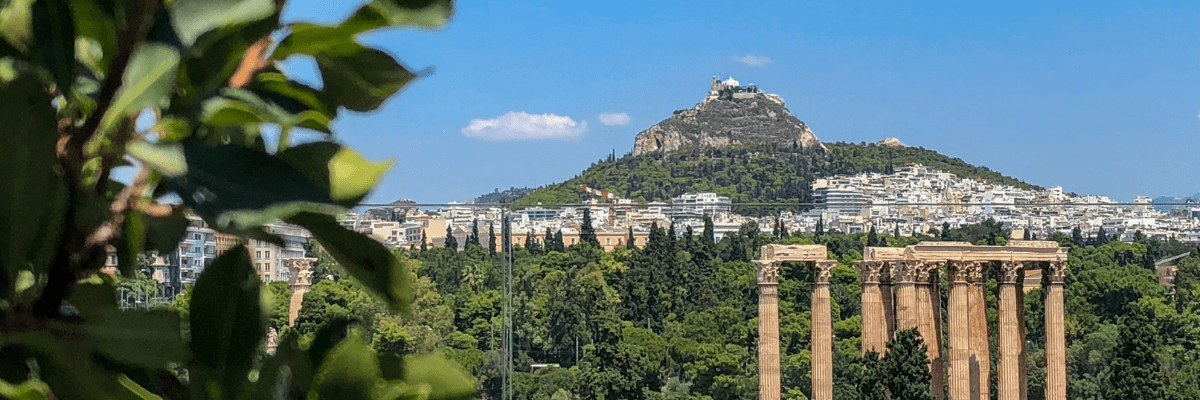Strolling the streets of Athens combines modern city life and the historical layers of Ancient Greece.
Disclosure: Some links on our site are affiliate links. If you purchase a linked item, we will make a commission, at no extra charge to you.
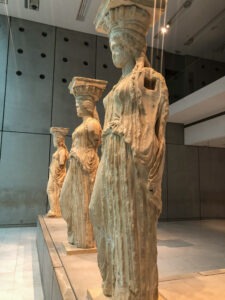
But Athens isn’t just a city frozen in time; it also embraces modernity and the bustling energy of a thriving metropolis. Strolling the streets of Athens combines both worlds, as you experience modern city life alongside the historical layers of Ancient Greece. With a vibrant street art scene, trendy cafes, and lively markets, Athens has something for everyone. So, whether you’re a history buff or a lover of contemporary culture, Athens is the perfect destination for your next travel adventure. Join us as we explore the fascinating blend of old and new in this vibrant city.
- The Acropolis – Located atop a hill in the heart of Athens and the most famous mythical landmark in the city. The Acropolis is home to the Parthenon, the Temple of Athena Nike, and the Erechtheion. These structures were dedicated to the city’s patron goddess, Athena, and are a testament to the city’s mythical heritage.
- The Temple of Olympian Zeus – Nestled into the center of Athens, the temple was dedicated to the king of the gods, Zeus. Although only a few columns remain today, the temple once housed a statue of Zeus that was considered one of the Seven Wonders of the Ancient World.
- The Ancient Agora – The center of political, commercial, and social life in ancient Athens. The Agora was also the location of the Temple of Hephaestus, dedicated to the god of blacksmiths and fire.
- The Theater of Dionysus – The birthplace of Greek tragedy and dedicated to Dionysus, the god of wine and revelry, the theater was used for performances of plays by famous playwrights such as Sophocles, Euripides, and Aristophanes.
- The Panathenaic Stadium – The stadium is a marvel of ancient engineering and a symbol of the birthplace of the modern Olympic Games. This magnificent stadium was originally built in the 4th century BCE to host the Panathenaic Games, which were held in honor of the goddess Athena. The stadium was rebuilt in marble by the Roman emperor Hadrian in 144 CE, and it is the only stadium in the world made entirely of marble. The stadium can seat up to 50,000 spectators and features a 204.07-meter-long track that is still used today for international athletic events. Visitors to the stadium can also see an impressive collection of Olympic torches, medals, and other memorabilia on display, as well as learn about the history of the Olympic Games and their significance in ancient and modern times. Perhaps the most fun event you can do at the stadium is a lap on the track! (See our article on the birthplace of the Olympics here)
- The National Archaeological Museum – Housing an extensive collection of ancient Greek artifacts, including the Antikythera Mechanism, one of the earliest known examples of an astronomical calculator.
- Acropolis Museum – Entering the museum you will walk across archeological digs below glass before discovering a treasure trove of ancient Greek artifacts illustrating the city’s rich history and mythology. The museum’s most notable display is the Parthenon Gallery, which houses the surviving sculptures from the Parthenon temple, one of the most iconic buildings of the ancient world. Visitors can marvel at the intricate details of the frieze, which depicts the Panathenaic procession, a religious festival in honor of the goddess Athena. The museum also features an impressive collection of ancient pottery, including the famous black-figure and red-figure vases, which were used for everyday purposes as well as for religious rituals. One of the most fascinating displays is the Archaic Gallery, which showcases the early development of Greek sculpture and includes the famous Moschophoros statue.
- The Benaki Museum – This museum is one of the most important cultural institutions in Greece, and it houses a diverse collection of Greek artifacts, from ancient times to the present day.
- The Parthenon – This iconic temple, located on the Acropolis, was dedicated to the goddess Athena and is considered one of the finest examples of ancient Greek architecture.
- The Plaka Neighborhood – This charming and historic area located at the base of the Acropolis is a great place to wander through narrow streets lined with shops, restaurants, and tavernas, and see traditional Greek architecture.
- The Syntagma Square – This central square is the heart of modern Athens and is surrounded by important buildings, such as the Greek Parliament and the Tomb of the Unknown Soldier. Visit the square to see the Changing of the Guard ceremony every hour on the hour. During the ceremony. the Evzones (elite members of the Greek Presidential Guard) perform a solemn and carefully choreographed ceremony, complete with intricate footwork, symbolic gestures, and traditional costumes.
- Mount Lycabettus – Providing panoramic views of Athens the hill is a popular destination for both tourists and locals.
- The Kerameikos Cemetery – This ancient cemetery was the final resting place for many Athenians.
- The Tower of Winds and the Wind Gods – The field of meteorology is not a recent development in human history. In fact, the world’s inaugural meteorological station was situated in Athens’ Roman Agora, over 2,000 years ago. Known as the Horologion of Andronikos Kyrrhestes, this ingenious construction served multiple functions, including operating as a sundial, compass, weathervane, and water clock. Located on the slopes of the Acropolis, this octagonal tower was powered by water from a nearby spring and displayed both time and wind direction.
The Tower of the Winds was renowned for its intricate embellishments, notably its bas-relief sculptures illustrating the eight wind gods. In Ancient Greek mythology, these deities were revered as formidable and unpredictable forces that could bring both blessings and calamity. Each wind god was linked to a particular cardinal direction and portrayed with their unique wind-controlling instruments.
The Tower of the Winds reflects the engineering and architectural skills of the ancient Greeks, as well as their progress in astronomy, meteorology, and mythology.
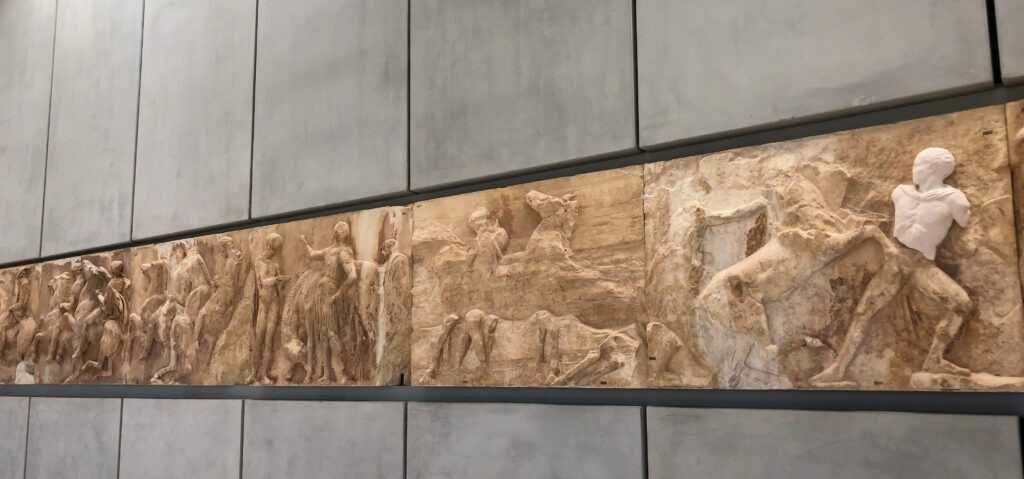
- Divine Contest – The contest between Athena and Poseidon determined the city’s patron and ultimate name. According to mythology, each offered a gift to gain the approval f the people and the gods. Poseidon offered a saltwater spring. Athena an olive tree. The olive tree was deemed favorable, The Goddess of Wisdom won, and Athens was born.
- The Areopagus Hill and the God of War – The Areopagus Hill in Athens, Greece is steeped in ancient mythology and history. It was here that the god of war, Ares, was put on trial for murder, and subsequently punished by the gods. This trial reflects the importance of justice and the rule of law in ancient Greek culture. Today, the hill is a fascinating tourist destination, where visitors can explore the remains of the ancient court and enjoy stunning views of the city. Discover the site where even the gods were held accountable for their actions, and where justice was dispensed with divine authority.
- The Temple of Hephaestus and the Birth of the Erichthonius – Dedicated to the god of fire, metalworking, and blacksmiths this temple was built in the 5th century BC and is one of the best-preserved examples of ancient Greek architecture. According to mythology, the temple was also the birthplace of the legendary king Erichthonius, who was born from the earth after his father, Hephaestus, attempted to rape the goddess Athena.
- The Archeological Site of Elemis’s and the Gate to the Underworld – The Archaeological Site of Eleusis is an ancient and mysterious site located in the suburbs of Athens, Greece. It was once home to the secretive Eleusinian Mysteries, an annual religious ritual that granted initiates a glimpse into the afterlife. The site was considered a gate to the underworld, making it one of the holiest places in the ancient world. Today, visitors can explore the well-preserved remains of the site and learn about the myths and history associated with this fascinating place. It offers a unique glimpse into ancient Greek religion and culture, making it a must-visit for anyone interested in the mysteries of the afterlife.
- The Temple of Olympian Zeus and the great Titanomachy – Once one of the largest temples in the world, only a few columns remain today. In Greek mythology, Zeus played a pivotal role in the Titanomachy. The ten-year war between the older Titans and the younger Olympian gods. This mythological conflict represented a struggle between the old and new orders, with the Olympians emerging victorious and Zeus becoming the ruler of all the gods.
- Cape Sounion and the Naming of the Aegean Sea – Embark on a mythical journey to the kingdom of Poseidon, ruler of the seas in Greek mythology, just a short ride from Athens through the stunning ‘Athens Riviera’. Witness the grandiose Temple of Poseidon and meet an old king patiently waiting on the cliff’s edge, gazing at the endless blue below, for his heroic son to return from his quest. Discover the story of Theseus, the founding father of Athens, and his adventure to Crete and the mythical palace of King Minos. Experience the thrill of the waves bringing him closer and closer back to his father as a hero. Be mesmerized by the glorious sunset, waiting alongside the hero’s father, to see whether his son’s sails will be white or black… the difference between life and death.
- Athens Metro Stations – Discover the fascinating history of Athens through its transportation systems and bus stations. Europe’s oldest capital city is home to a metro line that dates back to 1869, featuring ancient aqueducts and riverbeds. Monastiraki Station boasts remnants of an ancient vaulted riverbed, while Syntagma and Evangelismos Stations showcase ancient aqueducts. Furthermore, some bus stations in Athens, particularly those in the city center, were built on or near ancient sites, and incorporate remnants of ancient structures into modern buildings. Visitors can explore archaeological sites such as the Ancient Agora and the Kerameikos Cemetery, which are located near bus stations and offer a glimpse into Athens’ rich history.
- Socrates’ Prison – One of the most significant events in Socrates’ life was his imprisonment and subsequent execution in Athens. Accused of corrupting the youth and not recognizing the gods of the state, Socrates was imprisoned in the Athens city jail. It is believed that he spent his final days there while awaiting his execution. Although the original prison is no longer standing, visitors can see a replica of Socrates’ cell and learn about his life, teachings, and legacy.
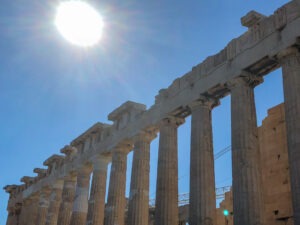
Get to Know Athens
- Athens is the capital of Greece and the heart of ancient Greece
- Europe’s oldest capital with an origin about 3400 years ago
- Hosts about 18 million tourists per year
- Athens is home to one of Greece’s eighteen UNESCO World Heritage Sites- the Acropolis of Athens
- The area has experienced almost every form of government (monarchy, democracy, socialism, capitalism, communism)
- It is the birthplace of democracy as the first home to known democracy (established around 500 BC)
- Home to the most theater ICAC stages in the world (149 stages which is more than the West End and Broadway…combined)
- The first-ever play performed in Athens
- The ancient Olympic Games were never held here
- The 2004 Olympic Games led to the greatest archeological excavation in the Athens era. More than 50,000 artifacts were excavated in the building of the Athens Metro.
- The Hotel Grande Bretagne is the oldest hotel in Athens. Located in Syntagma Square the hotel was used as a royal guesthouse in the 19th century and served as Nazi headquarters during the German occupation of Athens in World War II.
